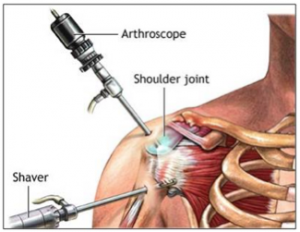A distal clavicle excision is a procedure used for impingement in the shoulder. Shoulder impingement is a condition where the space between the joint structures narrows, causing parts to pinch or rub. Arthroscopy involves the use of a lighted camera to make necessary repairs to the acromioclavicular (AC) joint.
Who needs distal clavicle excision?
The AC joint is the space where the clavicle (collarbone) meets the acromion (bony prominence). This joint sits  above the rotator cuff tendons and the bursa. When this joint has impingement, it affects mobility and function of the shoulder. Damage to the AC joint can occur from trauma, injury, or osteoarthritis (degeneration).
above the rotator cuff tendons and the bursa. When this joint has impingement, it affects mobility and function of the shoulder. Damage to the AC joint can occur from trauma, injury, or osteoarthritis (degeneration).
Candidates for this procedure include anyone with symptoms of impingement, including limited range of motion, swelling, and pain.
Dr. Adam Farber with Phoenix Shoulder and Knee is an expert shoulder surgeon, Board Certified and Fellowship Trained. He offers the procedure in a minimally invasive fashion.
How do I prepare for the procedure?
Decisions made before surgery, as well as the actions, are just as much important as the procedure itself. Before your procedure, you should:
- Have all necessary equipment you will need, such as ice packs and a shoulder sling. It is also important to have things within reach, as overhead reaching is not permitted.
- Know the potential risks of the surgery so you can notify the physician if any changes occur.
- Report any physical issues to the surgeon, such as a fever or swelling.
- Make the doctor aware of past and current medical conditions and any medications you are taking.
- Stop using blood thinners and aspirin a week before the scheduled procedure.
What happens the day of surgery?
Do not eat or drink after midnight, have someone to drive you home following discharge, and leave all jewelry and valuables at home. When you arrive at the medical center, you will be sent to the holding area to prepare for the surgery. Paperwork is completed, and consent forms are signed. Once you are in the gown, the shoulder region is shaved (if needed), a nurse places an IV catheter in your arm, and the anesthesiologist goes over the anesthesia method with you.
What are the steps in the arthroscopic distal clavicle excision?
- Step 1 – After regional or general anesthesia is give, the Phoenix shoulder surgeon makes small incisions around the shoulder. The arthroscope is inserted by the surgeon through one of the incisions, and instruments are inserted in other incisions.
- Step 2 – The Arizona shoulder specialist excises the clavicle using special cutting tools. A portion of the impinging end is removed.
- Step 3 – The instruments and arthroscope are removed, and the incisions are closed with sutures. After bandaging the area, the arm is placed in a sling.
 What can I expect after surgery?
What can I expect after surgery?
You will be moved to a recovery area where a nurse monitors you after the procedure. An ice pack and medications are used to treat pain. You may have to stay in the medical center overnight, depending on your condition.
What should I do for home care?
After discharge, you must rest, ice the surgical site, and take prescribed medications. Report any increase in pain, changes in skin color, high temperature, and/or severe swelling to the physician. You are allowed to bathe after 7 days, but do not remove sutures. The sutures are usually removed 10-14 days after the procedure. You must continue to wear the sling for 3-6 weeks. Rest and ice are part of the initial recovery, and after a week, you must begin rehabilitation exercises. Physical therapy is used to return mobility and normal strength to the shoulder.


